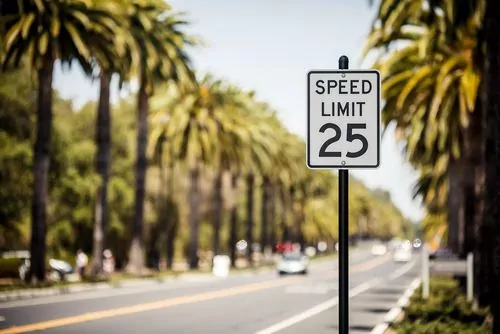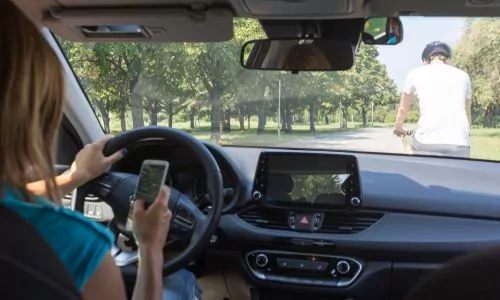As licensed drivers, we’ve all taken the initial written test and have a basic knowledge of traffic laws. However, as time goes by, it’s natural to forget some of the details. In addition to this, there’s another concern that we often do not take into consideration. While driving laws throughout the United States tend to be very similar, there are certain differences between the states. As a driver in New York, for example, you may make a decision while on vacation in Florida that would be completely legal in your state, but could get you a hefty fine or worse in The Sunshine State.
Conversely, laws that prevent you from making certain decisions or maneuvers at home may not exist in a state you’re visiting. This is important to know because, while you sit and wait for a light to change in a state that allows advanced turns on a red light, for example, you will receive the full wrath of those behind you! Also, there are laws that affect who will be at fault and who can obtain compensation in the event of an accident. Now, it isn’t realistic to expect drivers to know every traffic law in every state. However, there are certain rules you are more likely to find useful if traveling to a particular state – and those are the ones we’ll look at here!

Speeding Laws
Ask any driver which penalty they want to avoid the most, and chances are he or she will immediately answer “a speeding ticket.” Tickets can come with hefty fines and, worse yet, points on your license. By keeping your eyes peeled for speed limit signs, you can avoid tickets. Still, when used to driving at a certain speed in your home state, force of habit can quickly get you in trouble. If you know you’ll be traveling to another state, it’s a good idea to take a quick look at their default speed limits. This excellent guide outlines speed limits for cars and trucks when on rural interstates, urban interstates and other limited access roads in the different states and U.S. territories.
Remember, at all times speed limits must be considered “unless otherwise posted.” That means you should always be looking out for signs warning that the speed limit is different than the expected one. This can be the case due to road conditions, geographical concerns, construction or a host of other reasons. In addition to this, certain states have unique (and sometimes very surprising!) speeding laws.
- California –You may be familiar with a long-running controversy in California that concerns the use of radar in speeding enforcement. In short, like elsewhere in the country, ‘radar enforced’ signs are common throughout the state. However, some research into California’s speeding laws uncovers the fact that, except in certain situations (including local streets and school zones), comparing a radar reading to a posted speed limit is often inadmissible in court. Certain sections of the California Vehicle Code outline that, unless a speed limit has been set due to the results of an engineering and traffic survey, evidence gathered from radar and similar electronic measurement equipment is not admissible in court. Most often, the traffic survey in question must show that 85% of drivers drive at a speed no more than 5 miles per hour more than the posted speed limit (the 85th percentile speed). Since many areas either have had no such survey done or the 85th percentile drives more than 5 miles per hour above the speed limit (one town saw speeds as much as 14 mph over), radar evidence remains inadmissible in many areas. Of course, your best bet is to avoid any issues by adhering to posted speed limits.
- Arkansas, Idaho, Kentucky, Michigan, Minnesota, New Hampshire, North Dakota, Oregon, Pennsylvania, Texas, Utah, Wyoming –While most states have set speed limits for different types of roads (barring conditions, construction etc), these states often have segments that vary slightly. Thus, it’s a good idea to be particularly vigilant when driving in these states.
- Montana –Montana has a unique feature when it comes to speeding laws; on certain roads its speed limits actually change depending on whether it’s daytime or nighttime! Further, the limits differ not only between cars and trucks but also the additional classification of ‘light trucks.’
- Texas – With some of the busiest freeways and on-ramps in the nation, merging onto the freeway here is notoriously challenging. To prevent accidents, drivers are encouraged to accelerate to a freeway speed of up to 75 miles per hour when merging. To assist with that, specific laws exist, including drivers being allowed to legally accelerate along the shoulder so they may enter freeway traffic at appropriate speeds.
- Louisiana – Undoubtedly much to the chagrin of authorities, speed camera images can only be used to ticket motorists if the cameras are properly signposted.
- Idaho – If the speed limit is 55 mph or higher, motorists can exceed the speed limit by as much as 15 miles per hour when passing on two-lane state roads.
Turning Laws
All states allow right turns except where prohibited by signs or where traffic lights controlling right turns (e.g. advanced right turn lights) are present. One notable exception is in New York City, where the opposite is true (right turns are prohibited except where posted). However, the rules for turning left on a red vary from state to state.
- South Dakota, Connecticut, Maine, Missouri, New Hampshire, North Carolina, the District of Columbia, Guam and New York –These states expressly prohibit turning left on a red light.
- Idaho, Michigan, Oregon and Washington –These states allow left turns on a red light onto a one-way street, whether coming from a one-way or two-way street.
- The remaining 37 states (including Puerto Rico) –These states allow left turns on a red light onto a one-way street only when coming from a one-way street as well.

Texting/Mobile Device Laws
In the past fifteen years, mobile phone ownership has become extremely widespread. As a result, the nation and its states have created legislation to prevent motorists from being distracted by their use. It’s no secret that many avoidable accidents, some of them fatal, have been caused by texting or making/taking voice calls while driving. While most states have some kind of cell phone restriction law, they vary widely from state to state. Here are a few examples:
- California, Connecticut, Delaware, Georgia, Hawaii, Illinois, Maryland, Nevada, New Hampshire, New Jersey, New Mexico, New York, Oregon, Vermont, Washington, West Virginia, Washington D.C., Puerto Rico, Guam and the U.S. Virgin Islands –If you are in any of these states or territories, the law is simple; absolutely no hand held device use is allowed (this is distinct from hands-free calling). It is still advisable to check each state’s complete laws – for example, California bans any cell phone use whatsoever for drivers under 18 years old.
- Alabama, Arkansas, Louisiana, Maine, Oklahoma, Virginia –These states prohibit any cell phone use for certain groups considered to be inexperienced (e.g. drivers under 20 in Arkansas, or learner and intermediate license holders in Louisiana).
- Colorado –In 2017, Colorado changed its texting laws. Instead of a complete ban on texting, the law now states it is illegal to text in a “careless or imprudent manner.” However, as an increased deterrent, the penalties have been increased from a fine of $50 to $300, and from one license point to four.
- Florida –This state allows you to have cell conversations ‘if the sound only passes through one ear’ – i.e. a one-sided headset. Texting is a secondary violation (you must have been pulled over for another alleged offense to be charged) but legislators are working on making it a primary violation (you can be pulled over for this singular reason).
- New Hampshire – Recognized as one of the states with the most stringent mobile device laws, their penalization for multiple offenders may be one of the best deterrents in the country. First-time offenders are fined $100, second-time offenders $250, and someone caught a third time receives not only a $500 fine but also a two-year drivers license suspension.
There are many additional mobile device laws specific to the different states. Many states completely ban the use of mobile devices by school bus drivers, for instance, Other states (e.g. Wisconsin and Texas) ban use while driving through certain areas where distraction could put more people at risk, such as construction or school zones. At all times, the suggested behavior is to never use a handheld device – and if hands-free operation may be too distracting for road conditions, to pull over in a safe manner and location in order to have your conversation.

DUI/Interlock Laws
While distracted driving is certainly a hazard, it is a well-known fact that one of the most dangerous practices when it comes to operating a motor vehicle is drunk driving. As a result, every state has laws to deter drunk driving and to charge those found in violation. Across the nation, driving under the influence (DUI) laws exist. This means that, rather than having to prove a motorist was too intoxicated to operate a vehicle, any driver found having a blood alcohol content (BAC) of 0.08 or more is immediately guilty of (DUI). All states also have zero-tolerance laws for individuals under the legal drinking age of 21, while some have the same for inexperienced drivers or an impaired driver in a certain location (e.g school zone). A BAC level of 0.01 or 0.02 effectively means any alcohol imbibed will be picked up on a test, while certain states allow an underage driver to be charged even if an officer can smell alcohol on the individual. Here are some other drinking-related laws and penalties by state:
- Utah –In Utah, the maximum BAC level has been set at a paltry 0.05. This means that one stiff drink can conceivably put you in violation of the law. With this change, Utah now has the lowest tolerance for BAC level in the country.
- Alaska –With its remote location and drastic changes in temperature and sunlight, Alaska has long had problems with both alcoholism and DUI. To combat the problem, Alaska has instituted the highest maximum fine for a first offender: an astounding $1,500.
- Arizona – Though Alaska may have Arizona beat from a first offense fine standpoint, Arizona is widely considered to be the state with the ‘toughest’ DUI laws. First convictions carry a minimum fine of $750 – but also add minimum jail time of 10 days, a 90-day license suspension and mandatory installation of an interlock (car breathalyzer) device.
- Virginia – Virginia DUI laws could be considered fairly average, with one exception; a DUI in this state stays on your driving record for 11 years. This, of course, can be detrimental in many situations including applying for jobs, acquiring visas and crossing our northern and southern borders.
- New Jersey – Many states have an ‘enhanced penalty’ BAC level; if your blood alcohol content is at least this level (in most states it is around twice the legal limit) penalties become more severe. In New Jersey, that enhanced penalty limit is only 0.10 – so that ‘one extra drink’ can have serious consequences!
There are also some laws that are hard to believe are real! A few of these include:
- In New Jersey and Oregon, it is illegal to pump your own gas (except with a special permit).
- Oregon also allows, where signage is posted, for drivers to turn right on a stop sign without actually stopping.
- In Illinois, residents who owe child support or have had their ‘wildlife privileges’ suspended in any state are barred from claiming possession of roadkill.
While these may be some of the more pertinent (and entertaining) traffic laws in different states, there are of course thousands more. No one is expected to remember all the laws in their state, much less others, but a good starting point is learning what is required on your driving exam and refreshing your memory every so often. This helpful website allows you to download the driver’s manual from your specific state.
California’s Top Personal Injury Lawyers
Knowing your traffic laws can help you avoid accidents, whether you are a motorist, a cyclist or a pedestrian. Unfortunately, everything is not in our control, and despite adhering to the rules, accidents occur. When they do, a knowledgeable accident attorney can protect your legal rights and help to ensure any expenses you may have incurred, or will in the future, are well covered. Krasney Law is known as one of California’s best personal injury law firms and your case will get the attention it deserves. Contact us today to find out more about how we can help you, regardless of injury type.

